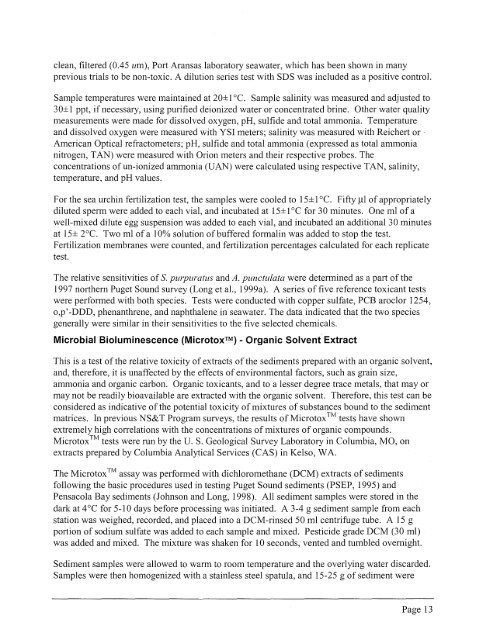Sediment Quality in Puget Sound Year 2 - Center for Coastal ...
Sediment Quality in Puget Sound Year 2 - Center for Coastal ...
Sediment Quality in Puget Sound Year 2 - Center for Coastal ...
Create successful ePaper yourself
Turn your PDF publications into a flip-book with our unique Google optimized e-Paper software.
clean, filtered (0.45 um), Port Aransas laboratory seawater, which has been shown <strong>in</strong> many<br />
previous trials to be non-toxic. A dilution series test with SDS was <strong>in</strong>cluded as a positive control.<br />
Sample temperatures were ma<strong>in</strong>ta<strong>in</strong>ed at 20± OC. Sample sal<strong>in</strong>ity was measured and adjusted to<br />
30± ppt, if necessary, us<strong>in</strong>g purified deionized water or concentrated br<strong>in</strong>e. Other water quality<br />
measurements were made <strong>for</strong> dissolved oxygen, pH, sulfide and total ammonia. Temperature<br />
and dissolved oxygen were measured with YSI meters; sal<strong>in</strong>ity was measured with Reichert or<br />
American Optical refractometers; pH, sulfide and total ammonia (expressed as total ammonia<br />
nitrogen, TAN) were measured with Orion meters and their respective probes. The<br />
concentrations of un-ionized ammonia (UAN) were calculated us<strong>in</strong>g respective TAN, sal<strong>in</strong>ity,<br />
temperature, and pH values.<br />
For the sea urch<strong>in</strong> fertilization test, the samples were cooled to 15± OC. Fifty p.1 of appropriately<br />
diluted sperm were added to each vial, and <strong>in</strong>cubated at 15±1 <strong>for</strong> 30 m<strong>in</strong>utes. One ml of a<br />
well-mixed dilute egg suspension was added to each vial, and <strong>in</strong>cubated an additional 30 m<strong>in</strong>utes<br />
at 15Â 2OC. Two ml of a 10% solution of buffered <strong>for</strong>rnal<strong>in</strong> was added to stop the test.<br />
Fertilization membranes were counted, and fertilization percentages calculated <strong>for</strong> each replicate<br />
test.<br />
The relative sensitivities of 5'. purpuratus and A. punctiilata were determ<strong>in</strong>ed as a part of the<br />
1997 northern <strong>Puget</strong> <strong>Sound</strong> survey (Long et al., 1999a). A series of five reference toxicant tests<br />
were per<strong>for</strong>med with both species. Tests were conducted with copper sulfate, PCB aroclor 1254,<br />
o,p7-DDD, phenanthrene, and naphthalene <strong>in</strong> seawater. The data <strong>in</strong>dicated that the two species<br />
generally were similar <strong>in</strong> their sensitivities to the five selected chemicals.<br />
Microbial Biolum<strong>in</strong>escence (Microtoxm) - Organic solvent Extract<br />
This is a test of the relative toxicity of extracts of the sediments prepared with an organic solvent,<br />
and, there<strong>for</strong>e, it is unaffected by the effects of environmental factors, such as gra<strong>in</strong> size,<br />
ammonia and organic carbon. Organic toxicants, and to a lesser degree trace metals, that may or<br />
may not be readily bioavailable are extracted with the organic solvent. There<strong>for</strong>e, this test can be<br />
considered as <strong>in</strong>dicative of the potential toxicity of mixtures of substances bound to the sediment<br />
matrices. hi previous NS&T Program surveys, the results of ~icrotox"^ tests have shown<br />
extremely high correlations with the concentrations of mixtures of organic compounds.<br />
~icrotox~~ tests were run by the U. S. Geological Survey Laboratory <strong>in</strong> Columbia, MO, on<br />
extracts prepared by Columbia Analytical Services (CAS) <strong>in</strong> Kelso, WA.<br />
The ~icrotox~~' assay was per<strong>for</strong>med with dichloromethane (DCM) extracts of sediments<br />
follow<strong>in</strong>g the basic procedures used <strong>in</strong> test<strong>in</strong>g <strong>Puget</strong> <strong>Sound</strong> sediments (PSEP, 1995) and<br />
Pensacola Bay sediments (Johnson and Long, 1998). All sediment samples were stored <strong>in</strong> the<br />
dark at 4OC <strong>for</strong> 5-10 days be<strong>for</strong>e process<strong>in</strong>g was <strong>in</strong>itiated. A 3-4 g sediment sample from each<br />
station was weighed, recorded, and placed <strong>in</strong>to a DCM-r<strong>in</strong>sed 50 ml centrifuge tube. A 15 g<br />
portion of sodium sulfate was added to each sample and mixed. Pesticide grade DCM (30 ml)<br />
was added and mixed. The mixture was shaken <strong>for</strong> 10 seconds, vented and tumbled overnight.<br />
<strong>Sediment</strong> samples were allowed to warm to room temperature and the overly<strong>in</strong>g water discarded.<br />
Samples were then homogenized with a sta<strong>in</strong>less steel spatula, and 15-25 g of sediment were<br />
Page 13







